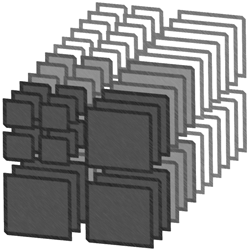
Local Average of Wavelet Coefficients


|
Local Average of Wavelet Coefficients |

|
|
In general, image coding systems determine the probabilities of the symbols emitted by the coding engine employing adaptive approaches that adjust the probabilities as more data are coded. After studying the statistical nature of wavelet-transformed images, we realized that the local neighborhood of a coefficient can already provide enough information to establish such probabilities with high precision. Following this idea, we developed a stationary model of probabilities that, without requiring adaptation, enhances the coding performance of the system and provides other advantages to the codec. This stationary model of probabilities was first developed for natural images, and then it was extended for 3D images (i.e., images with many components). |
| STATIONARY PROBABILITY MODEL FOR BITPLANE IMAGE CODING THROUGH LOCAL AVERAGE OF WAVELET COEFFICIENTS (natural images) |
|
ABSTRACT: This paper introduces a probability model for symbols emitted by bitplane image coding engines, which is conceived from a precise characterization of the signal produced by a wavelet transform. Main insights behind the proposed model are the estimation of the magnitude of wavelet coefficients as the arithmetic mean of its neighbors' magnitude (the so-called local average --LAV--), and the assumption that emitted bits are under-complete representations of the underlying signal. The local average-based probability model is introduced in the framework of JPEG2000. While the resulting system is not JPEG2000 compatible, it preserves all features of the standard. Practical benefits of our model are enhanced coding efficiency, more opportunities for parallelism, and improved spatial scalability. |
| PAPER: F. Auli-Llinas, Stationary probability model for bitplane image coding through local average of wavelet coefficients, IEEE Trans. Image Process., vol. 20, no. 8, pp. 2153-2165, Aug. 2011. (DOI:10.1109/TIP.2011.2114892, doc.pdf329K) |
| PRESENTATION: slides.pptx17M |
| LOSSY-TO-LOSSLESS 3D IMAGE CODING THROUGH PRIOR COEFFICIENT LOOKUP TABLES (3D images) |
|
ABSTRACT: This paper describes a low-complexity, high-efficiency, lossy-to-lossless 3D image coding system. The proposed system is based on a novel probability model for the symbols that are emitted by bitplane coding engines. This probability model uses partially reconstructed coefficients from previous components together with a mathematical framework that captures the statistical behavior of the image. An important aspect of this mathematical framework is its generality, which makes the proposed scheme suitable for different types of 3D images. The main advantages of the proposed scheme are competitive coding performance, low computational load, very low memory requirements, straightforward implementation, and simple adaptation to most sensors. During the reviewing process, some reviewers asked for more experimental results, which can be found here. |
| PAPER: F. Auli-Llinas, M.W. Marcellin, J. Serra-Sagrista, and J. Bartrina-Rapesta, Lossy-to-lossless 3D image coding through prior coefficient lookup tables, ELSEVIER Information Sciences, vol. 239, no. 1, pp. 266-282, Aug. 2013. (DOI:10.1016/j.ins.2013.03.027, doc.pdf607K) |
| PRESENTATION: slides.pptx2.4M |